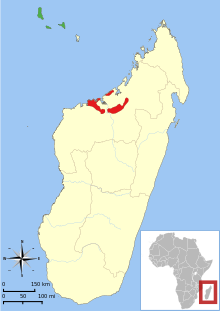| Mongoose lemur | |
|---|---|

| |
| Mongoose lemur at Cleveland Metroparks Zoo | |
| Scientific classification | |
| Domain: | Eukaryota |
| Kingdom: | Animalia |
| Phylum: | Chordata |
| Class: | Mammalia |
| Order: | Primates |
| Suborder: | Strepsirrhini |
| Family: | Lemuridae |
| Genus: | Eulemur |
| Species: | E. mongoz
|
| Binomial name | |
| Eulemur mongoz | |

| |
| Distribution of E. mongoz:[1]red = native, green = introduced | |
| Synonyms | |
| |
The mongoose lemur (Eulemur mongoz) is a small primate in the family Lemuridae, native to Madagascar and introduced to the Comoros Islands. These arboreal animals have pointed faces, long, bushy tails, dark-brown upper parts, pale bellies, and beards, which are reddish in males and white in females. They live in family groups and feed primarily on fruit, but also eat leaves, flowers, and nectar, with nectar from Ceiba pentandra trees making up a large part of their diet during the dry season. They have declined sharply in numbers because of habitat destruction and hunting, and the International Union for Conservation of Nature has rated their conservation status as "critically endangered".
- ^ a b Razafindramanana, J.; Eppley, T.M.; Rakotondrabe, R.; Roullet, D.; Irwin, M.; King, T. (2020). "Eulemur mongoz". IUCN Red List of Threatened Species. 2020: e.T8202A115561431. doi:10.2305/IUCN.UK.2020-2.RLTS.T8202A115561431.en. Retrieved 19 November 2021.
- ^ "Checklist of CITES Species". CITES. UNEP-WCMC. Retrieved 18 March 2015.
- ^ Groves, C. P. (2005). Wilson, D. E.; Reeder, D. M. (eds.). Mammal Species of the World: A Taxonomic and Geographic Reference (3rd ed.). Baltimore: Johns Hopkins University Press. p. 115. ISBN 0-801-88221-4. OCLC 62265494.
